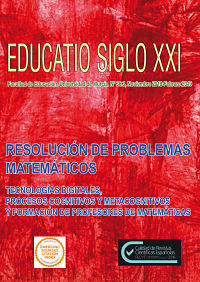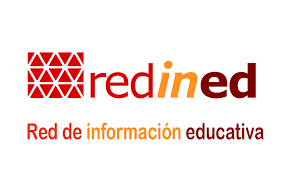The role of technology in the development of mathematical understanding through problem solving
Abstract
The use of digital technologies has incorporated new reflection elements to approach the problem of mathematics learning since these tools can uncover elements that could be hidden when students use pencil and paper to solve problems. For instance, to describe how the volume of a liquid in a container changes when the height of that liquid is modified requires the student to imagine how the change occurs. However, with the use of digital technologies,
the student can visualize such variation and focus his attention on other important aspects such as the rates of change or the way in which that change occurs. In this paper we report some results from a study conducted with a group of students that used GeoGebra to approach mathematical tasks aimed at exploring students’ understanding regarding functional relations derived from sketching graphs that describe volume as a function of the height of a liquid in a container. The tasks were solved by first semester students of a Bachelor Degree program in mathematics at a Mexican Public University. Collected data were analysed from a socioconstructivist epistemological perspective as well as a didactical view that privileges mathematical understanding through problem solving. The analysis units were the reasoning sequences developed by the students. The systematic use of technology fostered a development of students’ conceptual structures of quantitative and qualitative types. We also identified some limitations of the tool to promote the organization of ideas, especially those that refer to the concavity of the sketched graphs.
Downloads
-
Abstract1629
-
PDF (Español (España))1171
References
Barrera-Mora, F., & Reyes-Rodriguez, A. (2016). Designing technology-based tasks for enhancing mathematical understanding through problem solving. In L. Uden, D. Liberona and B. Feldmann (Eds.), Learning technology for education in cloud: The changing face of education (pp. 183-192). Switzerland: Springer.
Berger, W. (2014). A more beautiful question: The power of inquiry to spark breakthrough ideas. New York, NY: Bloomsbury.
Brown, C. & Borko, H. (1992). Becoming a mathematics teacher. In D. A. Grouws (Ed.), Handbook of research on mathematics teaching and learning (pp. 209-239). New York: Macmillan.
Carlson, M. P., Jacobs, S., Coe, E., Larsen, S., & Hsu, E. (2002). Applying covariational reasoning while modeling dynamic events: A framework and a study. Journal for Research in Mathematics Education, 33(5), 352–378.
Carlson, M. P., Larsen, S., & Lesh, R. A. (2003). Integrating a models and modeling perspective with existing research and practice. In R. A. Lesh and H. Doerr (Eds.), Beyond constructivism: Models and modeling perspectives on mathematics problem solving, learning and teaching (pp. 465-478). Mahwah, NJ: Lawrence Erlbaum Associates.
Chimhande, T., Naidoo, A., & Stols, G. (2017): An analysis of Grade 11 learners’ levels of understanding of functions in terms of APOS theory. Africa Education Review, 14(3-4), 1-19.
Cobb, P., Wood, T., Yackel, E., Nichols, J., Wheatley, G., Trigatti, B., & Perlwitz, M. (1991). Assessment of a problem-centered second grade mathematics project. Journal for Research in Mathematics Education, 22, 3-29.
de Beer, H., Gravemeijer, K., & van Eijck, M, (2015). Discrete and continuous reasoning about change in primary school classrooms. ZDM Mathematics Education, 47, 981-996.
de Beer, H., Gravemeijer, K., & van Eijck, M. (2017). A proposed local instruction theory for teaching instantaneous speed in grade five. The Mathematics Enthusiast, 14(1), Article 24. Recuperado el 16 de marzo de 2017 de http://scholarworks.umt.edu/tme/vol14/iss1/24
De Faria-Campos, E. (2004). Funciones embotelladas. En L. Díaz (Ed.), Acta Latinoamericana de Matemática Educativa (pp. 584-589). México: Comité Latinoamericano de Matemática Educativa.
Donald, M. (1993). Origins of the modern mind. Cambridge, Massachusetts: Harvard University Press.
Drijvers, P. (2015). Digital technology in mathematics education: Why it works (or doesn’t). In S. J. Cho (Ed.), Selected regular lectures from the 12th International Congress on Mathematical Education (pp. 135-151). Cham: Springer.
Glaister, E. & Glaister, P. (2006). Introducing conics without eccentricity. International Journal of Mathematical Education in Science and Technology, 37(2), 235-245.
Heid, M. K., Lunt, J., Portnoy, N., & Zembat, I. O. (2006). Ways in which prospective secondary mathematics teachers deal with mathematical complexity. In S. Alatorre, J. L. Cortina, M. Sáiz & A. Méndez (Eds.), Proceedings of the 28th annual meeting of the North American Chapter of the International Group for the Psychology of Mathematics Education (Vol. 2, pp. 2-9). Mérida, Mexico: PME-NA.
Hitt-Espinosa, F. (1995). Intuición primera versus pensamiento analítico: dificultades en el paso de una representación gráfica a un contexto real y viceversa. Educación Matemática, 7(1), 63-75.
Johnson, H. L. (2012). Reasoning about quantities involved in rate of change as varying simultaneously and independently. In R. Mayes & L. L. Hatfield (Eds.), Quantitative reasoning and mathematical modeling: A driver for STEM integrated education and teaching in context (Vol. 2, pp. 39-53). Laramie, WY: University of Wyoming College of Education.
Johnson, H. L. (2013). Designing Covariation Tasks to Support Students’ Reasoning about Quantities involved in Rate of Change. STEM Faculty Presentations. Paper 45. Recuperado el 16 de marzo de 2016 de http://source.ucdenver.edu/stem_presentations/45
Kaput, J. J., & Schorr, R. Y. (2008). Changing representational infrastructures changes most everything. In G. W. Blume & M. K. Heid (Eds.), Research on technology and the teaching and learning of mathematics: Cases and Perspectives (Vol. 2, pp. 211-253). Charlotte, NC: Information Age Publishing.
Kindle, J. H. (1970). Teoría y problemas de geometría analítica plana y del espacio (Trad. Luis Gutiérrez Díez y Ángel Gutiérrez Vázquez). México: McGraw-Hill.
Koehler, M. J. & P. Mishra (2009). What is technological pedagogical content knowledge? Contemporary Issues in Technology and Teacher Education, 9(1), pp.60-70.
Lehmann, C. (1990). Geometría Analítica (Díaz, R. Trad.). México: Limusa. (Primera edición 1942).
Lithner, J. (2008). A research framework for creative and imitative reasoning. Educational Studies in Mathematics, 67(3), 255-276.
Mishra, P. & Koehler, M. (2006). Technological Pedagogical Content Knowledge: A new framework for teacher knowledge. Teachers College Record, 108 (6), 1017-1054.
Moreno-Armella, L. (1996). Mathematics: a historical and didactic perspective. International Journal of Mathematical Education in Science and Technology, 27(5), 633-639.
Moreno-Armella, L. (2002). Fundamentación cognitiva del currículo matemático. En Ministerio de Educación Nacional (Ed.), Memorias del Seminario Nacional Formación de Docentes sobre el Uso de Nuevas Tecnologías en el Aula de Matemáticas (pp. 40-66). Bogotá, Colombia: Ministerio de Educación Nacional.
Moreno-Armella, L., & Santos-Trigo, M. (2008). Democratic access and use of powerful mathematics in an emerging country. In L. D. English (Ed.), Handbook of International Research in Mathematics Education, 2nd Edition (pp. 319-351). New York: Taylor & Francis.
Moreno-Armella, L., & Santos-Trigo, M. (2015). The use of digital technology in mathematical practices. In L. D. English and D. Kirshner (Eds.), Handbook of International Research in Mathematics Education, 3rd Edition (pp. 595-616). New York: Roudledge.
Moreno-Armella, L., Hegedus, S. J., & Kaput, J. J. (2008). From static to dynamic mathematics: historical and representational perspectives. Educational Studies in Mathematics, 68, 99-111.
National Council of Teachers of Mathematics (NCTM) (2010) Mathematics Curriculum. Issues, Trends, and Future Directions, edited by Reys, B.J., Reys, R.E. and Rubenstein, R., The Council, Reston, VA.
Pea, R. D. (1987). Cognitive technologies for mathematics education. En A. Schoenfeld (Ed.), Cognitive Science and Mathematics Education (pp. 89-122). Hillsdale: Erlbaum.
Reyes-Rodríguez, A., Vargas-Alejo, V., Cristobal-Escalante, C., y Soberanis-Cruz, V. (2015). Formas de razonamiento que emergen al resolver problemas de máximos y mínimos con un SGD. Epsilon. Revista de Educación Matemática, 91, 7-24.
Santos-Trigo, M. (2007). La resolución de problemas matemáticos: fundamentos cognitivos. Mexico: Trillas.
Santos-Trigo, M. (2014). Problem solving in mathematics education. In S. Lerman (ed.), Encyclopedia of Mathematics Education (pp. 496-501). New York: Springer.
Santos-Trigo, M. (2015). La construcción de modelos dinámicos en el estudio de fenómenos de cambio o variación y la resolución de problemas. En C. Azcárate, M. Camacho-Machín, M. T. González y M. Moreno (Coords.), Didáctica del Análisis Matemático: una revisión de las investigaciones sobre su enseñanza y aprendizaje en el contexto de la SEIEM (pp. 163-177). La Laguna: Universidad de la Laguna.
Santos-Trigo, M. (2018). Problematizar los contenidos y la tecnología digital. C2 Ciencia y cultura. Recuperado de http://www.revistac2.com/problematizar-los-contenidos/ el 26 de julio de 2018.
Santos-Trigo, M. & Moreno-Armella, L (2016). The Use of Digital Technology to Frame and Foster Learners' Problem-Solving Experiences. In P. Felmer, E. Pehkonen & J. Kilpatrick (Eds.), Posing and Solving Mathematical Problems. Advances and new perspectives (pp. 189-207). Switzerland: Springer.
Sarama, J., & Clements, D.H. (2009). Early childhood mathematics education research: Learning trajectories for young children. New York: Routledge.
Schoenfeld, A. H. (1992). Learning to think mathematically: Problem solving, metacognition, and sense-making in mathematics. In D. Grouws (Ed.), Handbook for Research on Mathematics Teaching and Learning (pp. 334-370). New York: MacMillan.
Shell Centre for Mathematical Education [SCME] (1985). The language of functions and graphs: An examination module for secondary schools. Manchester, U.K.: Joint Matriculation Board.
Shulman, L. (1986). Those who understand: Knowledge growth in teaching. Educational Researcher, 15(2), 4-14.
Simon, M. A. (1994). Learning mathematics and learning to teach: Learning cycles in mathematics teacher education. Educational studies in mathematics, 26(1), 71-94.
Stein, M. K. & Smith M. S. (1998). Mathematical tasks as a framework for reflection: From research to practice. Mathematics Teaching in the Middle School, 3, 268-275.
Tabach, M. (2011). A mathematics teacher’s practice in a technological environment: A case study analysis using two complementary theories. Technology, Knowledge and Learning, 16(3), pp. 247-265.
Thompson, P. W., Byerley, C., & Hatfield, N. (2013). A conceptual approach to calculus made possible by technology. Computers in the School, 30, 124-147.
Vygotsky, L. S. (1962). Thought and language. Cambridge, MA: MIT Press.
Vygotsky, L. S. (1978). Mind in society: The development of the higher psychological processes. Cambridge, MA: Harvard University Press.
Wertsch, J. V. (1993). Voices of the Mind: A Sociocultural Approach to Mediated Action. Cambridge, Massachusetts: Harvard University Press.
Original work publishes in this journal is subject to the following terms:
1. Murcia University Press (the publishing house) holds the copyright of the publishes work, and favours and allows their reutilization under the use license stated in point 2.
© Servicio de Publicaciones, Universidad de Murcia, 2015
2. Work is published in the electronic edition under a license (Creative Commons Reconocimiento-NoComercial-SinObraDerivada 4.0 España (legal text). They can be copied, used, disseminated, transmitted and publicly presented, as long as: i) authorship and original publication source is acknowledged (journal, publishing house and URL of the work); ii) are not used for commercial purposes; iii) the existence and specifications of this use license is stated.
3. Conditions for self-archive. Authors are allowed and encouraged to disseminate electronically the pre-pint (before review) and/or post-print (accepted for publication) versions of their work before their publication since that favours earlier circulation and dissemination resulting in an increased chance for the authors to be cited and for the work to reach a bigger share of the academic community. Colour: RoMEO: green.








